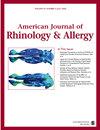吸入性过敏原对特应性皮炎临床表现的作用
IF 2.5
3区 医学
Q1 OTORHINOLARYNGOLOGY
引用次数: 0
摘要
背景吸入性过敏原是导致特应性皮炎(AD)患者出现临床症状的环境因素之一:方法使用三个数据库进行文献综述:PubMed/MEDLINE、ClinicalKey 和 Web of Science。检索词包括 "特应性皮炎"、"特应性湿疹 "和 "湿疹",并与 "吸入性过敏原"、"吸入性过敏原 "和 "航空过敏原 "结合使用,以找出强调 AD 与吸入性过敏原暴露之间关系的已发表的相关手稿。纳入综述的研究通过支气管激惹、皮肤直接接触和过敏原致敏等方法调查了吸入性过敏原对 AD 临床表现的影响。吸入性过敏原可通过支气管激发或直接皮肤接触加重 AD 症状。对吸入性过敏原(主要是屋尘螨)的致敏遵循特定的年龄相关模式。本文章由计算机程序翻译,如有差异,请以英文原文为准。
The Role of Inhalant Allergens on the Clinical Manifestations of Atopic Dermatitis
BackgroundInhalant allergens provide a source of environmental factors that contribute to the development of clinical symptoms in patients with atopic dermatitis (AD).ObjectiveTo review the relationship between inhalant allergens and AD.MethodsA literature review was conducted using three databases: PubMed/MEDLINE, ClinicalKey, and Web of Science. Search terms, including “atopic dermatitis,” “atopic eczema,” and “eczema,” were used in combination with “inhalant allergen,” “inhaled allergen,” and “aeroallergen” to identify relevant published manuscripts that highlight the relationship between AD and exposures to inhalant allergens.ResultsFifteen articles were suitable for review. The studies included in the review investigated the effect of inhalant allergens on the clinical manifestations of AD through bronchial provocation, direct skin contact, and allergen sensitization.ConclusionThere is a significant relationship between exposures to inhalant allergens and AD. Inhalant allergens may aggravate AD symptoms by either bronchial provocation or direct skin contact. Sensitization of inhalant allergens, mainly house dust mites, follows a specific age-related pattern.
求助全文
通过发布文献求助,成功后即可免费获取论文全文。
去求助
来源期刊
CiteScore
5.60
自引率
11.50%
发文量
82
审稿时长
4-8 weeks
期刊介绍:
The American Journal of Rhinology & Allergy is a peer-reviewed, scientific publication committed to expanding knowledge and publishing the best clinical and basic research within the fields of Rhinology & Allergy. Its focus is to publish information which contributes to improved quality of care for patients with nasal and sinus disorders. Its primary readership consists of otolaryngologists, allergists, and plastic surgeons. Published material includes peer-reviewed original research, clinical trials, and review articles.

 求助内容:
求助内容: 应助结果提醒方式:
应助结果提醒方式:


